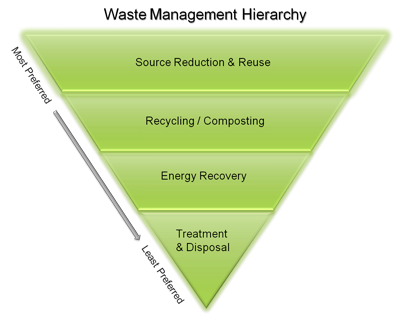System Overview
People living in the United States, in 2018, generated 292.4 million tons of municipal solid waste (MSW), or 4.9 pounds per person per day. While people recycle more, they also generate 70% more MSW today than they did in 1960.1 These MSW figures include common trash, excluding industrial, hazardous, and construction and demolition waste.
In federal buildings, solid waste management is the management of discarded or abandoned material from purchases, consumption by-products (example, cardboard packaging) and end products (example, discarded lamps). The Waste Management Hierarchy2 illustrates a basic framework for managing materials to reduce waste, from most sustainably preferable at the top to least sustainably preferable at the bottom.
- Source reduction, also known as waste prevention, means reducing waste at the source, and is the most environmentally preferred strategy. It is the elimination of waste before it is created and is the preferred approach because waste that never gets created doesn’t have waste management costs. Organizations that provide goods and services, can reduce waste through changes in the design, manufacture, purchase, or use of materials or products, including packaging. Reusing, repairing, and repurposing products and materials prevents or delays the entry of those items into the waste collection and disposal system.
- Recycling is the process of collecting and processing materials (that would otherwise be thrown away as trash) and remanufacturing them into new products (other than fuel for producing heat or power by combustion). Composting is the recycling of organic wastes, like food, leaves, grass clippings, and other organic materials into a nutrient-rich soil amendment. The world population in 2019 was 7.7 billion, and it is expected to reach 9.7 billion by 2050. To meet materials demand, innovative solutions are needed for resource recovery and the use of waste for material in the manufacturing process, part of a circular economy
 .
. - Recovery of Energy, or Waste to Energy (WTE), is the conversion of waste materials into usable heat, electricity, and fuel. Ash or metals, generated after the combustion process, can be recovered for commercial use or sent to a landfill. WTE facilities generate carbon dioxide and other greenhouse gas emissions, which contribute to climate change.
- Treatment & Disposal (landfill or incineration without energy recovery), is the least environmentally preferable waste management option because there is no beneficial use of the material to offset virgin material extraction. Landfills also generate methane, a potent greenhouse gas that contributes to climate change.
Solid Waste Components
- Facility-Wide
- Loading Dock Exterior
- Loading Dock Interior
- Break Pantry
- Support Area



